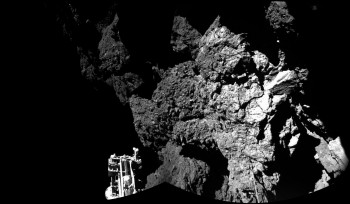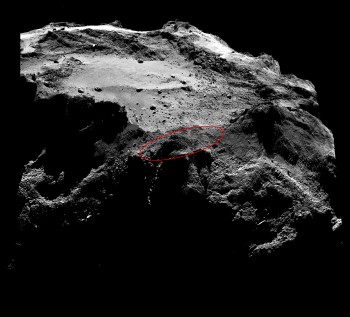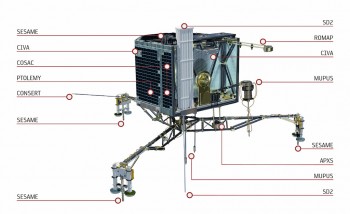This week, Rosetta will begin listening for signs that Philae is still “alive”. This report is provided by the German Aerospace Center, DLR.
It would be very lucky if a signal were to be received from Philae at 05:00 CET on 12 March 2015. The lander finally came to rest on 12 November 2014 in a rather shaded location on Comet 67P/Churyumov-Gerasimenko and it needs to receive sufficient energy before it can wake up and begin communicating. This is, however, the first possibility to receive a signal from Philae; therefore, the communication unit on the Rosetta orbiter will be switched on to call the lander.
“Philae currently receives about twice as much solar energy as it did in November last year,” says Lander Project Manager Stephan Ulamec from the German Aerospace Center (Deutsches Zentrum für Luft- und Raumfahrt; DLR).
Today, Comet 67P/Churyumov-Gerasimenko, Rosetta and Philae are 320 million kilometres from the Sun.
“It will probably still be too cold for the lander to wake up, but it is worth trying. The prospects will improve with each passing day,” says Ulamec.

Philae’s view of the cliffs at Abydos. One of the lander’s three feet can be seen in the foreground.
Credits: ESA/Rosetta/Philae/CIVA
Waking up at the right temperature and energy
Several conditions must be met for Philae to start operating again and allow the DLR Lander Control Center to put it to work. First, the interior of the lander must be at least at –45ºC before Philae can wake up from its winter sleep. At its new landing site – Abydos – only a little sunlight reaches Philae, and the temperatures are significantly lower than at the originally planned landing location. In addition, the lander must be able to generate at least 5.5 watts using its solar panels to wake up. It has not remained idle during hibernation.
“Philae is designed so that, since November 2014, it has been using all the available solar energy to heat up,” says Koen Geurts from the DLR Control Center.
As soon as Philae ‘realises’ that it is receiving more than 5.5 watts of power and its internal temperature is above –45ºC, it will turn on, heat up further and attempt to charge its battery.
Contact during comet daytime
Once awakened, Philae switches on its receiver every 30 minutes and listens for a signal from the Rosetta orbiter. This, too, can be performed in a very low power state.
“At this time, we do not yet know that the lander is awake,” says Geurts. “To send us an answer, Philae must also turn its transmitter – and that requires additional power.”
It could be that the lander has already woken up from its winter sleep some 500 million kilometres away from Earth, but does not yet have sufficient power to communicate with Rosetta, which relays Philae’s signal back to Earth. Philae needs a total of 19 watts to begin operating and allow two-way communication.
Between 12 and 20 March, the Rosetta orbiter is transmitting to the lander and listening for a response. The most likely time for contact is during the 11 flybys where the orbiter’s path puts it in a particularly favourable position with respect to the lander during comet ‘daytime’ – when Philae is in sunlight and being supplied with power by its solar panels. Communication will be attempted continuously because Philae’s environment could have changed since landing in November 2014.

Lander search area. The image is a 2 x 2 mosaic comprising OSIRIS narrow-angle camera images taken on 13 December 2014 from a distance of about 20 km to the centre of the comet.Credits: ESA/Rosetta/MPS for OSIRIS Team MPS/UPD/LAM/IAA/SSO/INTA/UPM/DASP/IDA
Preparation for all eventualities
So far, Philae’s exact location has not been identified on images acquired by the Optical, Spectroscopic, and Infrared Remote Imaging System (OSIRIS) on board the Rosetta orbiter, so the operations team at DLR is currently working with the information they have from the lander’s cameras: the Comet nucleus Infrared and Visible Analyser (CIVA) and the ROsetta Lander Imaging System (ROLIS), along with the knowledge gained from the solar energy conditions experienced in November.
“However, we assume that the solar panels of Philae are shadowed but, by what, we cannot see in the previous images,” says Geurts.
The DLR engineers have therefore sent new commands to the lander that optimise the heating and provide energy savings to improve its chances of communication with Earth. Even if Philae does not have enough energy yet to answer, it could receive and execute these commands. This is referred to as ‘blind commanding’ by the engineers, because the lander is initially very unlikely give them feedback. These procedures were tested on the ground model at the DLR Microgravity User Support Center (MUSC). Even in the event that the rechargeable battery on board Philae did not survive the cold phase, the engineers are prepared.
“We are working to ensure that we can operate the lander and its instruments at least during the comet’s daytime, when it is in direct sunlight,” says Geurts.
Waiting for the health check
Once Philae wakes up and can also transmit, it will first send data about its ‘health’ to Earth.
“We will then evaluate the data. What is the state of the rechargeable battery? Is everything on the lander still functioning? What is the temperature? How much energy is it receiving?” says Geurts.
The scientific work with the 10 instruments on board Philae also depends on these results. If sufficient energy cannot be stored in the battery, the solar energy available during the comet daytime will determine whether a reduced version of the measurements can be performed. Currently, scientists believe that Philae is in sunlight for 1.3 hours. A day on 67P/Churyumov-Gerasimenko lasts 12.4 hours. If the battery can be charged as planned, measurements can be carried out during the comet night, enabling, for example, long-term measurements. What instrument is used and when will be determined by the team of scientists.
“If we cannot establish contact with Philae before 20 March, we will make another attempt at the next opportunity,” says Ulamec. “Once we can communicate with Philae again, the scientific work can begin.”
As the distance to the Sun decreases, the energy that the lander collects with its solar panels is becoming greater.










Discussion: 57 comments
Good luck Philae, good luck to the team as well!
Fingers crossed 🙂
Good luck Philae!
Hope!
Very optimistic. Good luck!
I’M STILL OPTIMIST, THE ODDS ARE THERE!
KEEP CLOSE TO UNDERTANDING WELL THE SIGNS OF LIFE…
Really good news. Waiting for Philae since November… thanks team Rosetta.
Wake up, Philae! Wake up, lazy boy!
I can’t wait anymore 🙂 see you tomorrow Philae. Good luck team 🙂
with all hopes am waiting to hear it has woken up and all the instruments are all in good shape,,, i got a feeling theres something unique about this comet that will bring forth more knowledge to us all the best guyz hopping for the best
Good lock from Germany, too!
Good Luck
I’m confident in ESA works. I’m sure Philae will resume work 😉
Good job and finger crossed as we can tell in France.
Hope to read about little Philae coming back and give new insights of comet. Fingers crossed, but I think engineering will make the big part. Congratulations for the fail recovery system!
Goodluck from Southern United States. I am rooting for Philae!
Good luck,I`m hoping the best!!!This mission is too important.Best wishes for the team,you´re doing a great job!
Having experienced and been a part of the European engineering effort for different Space projects I have seen the excellent standards which are worked to and the wonderful cooperation between involved parties. All of this careful design and dedication is right behind Rosetta and Philae, so it has the best possible chance imaginable of ‘waking up’ and being able to transmit telemetry again. Whatever turns out it has already proven itself beyond the dreams of us all. A gentle but astounding leap for mankind.
It’s 8:25 CET and no news yet. Please, please, please…
This first window of opportunity lasts until 20 March, so we may not hear something right away. We have to hope that Philae can meet the two primary wake-up requirements: that its internal temperature is at least –45ºC , and that it can generate at least 5.5 watts from the available solar energy.
We’ll let you know if and when we hear something – fingers crossed!
Thanks for your replay Emily. I just was wishing a signal from Philae. It would be so great to hear from her (for me it’s her). Well, It shall be so great when we hear from her.
Why does this window come to an end on the 20th March? What would the next opportunity be to try to contact Philae after that?
The opportunities depend on the Rosetta and Philae geometry, so mainly the comet rotation and Rosetta orbits. From 12-20 March they are good for communication; details on the next opportunities to be provided soon.
Good luck, my best wishes of success for all team!
Everything will be fine eventually. Good luck!!
time to be online now … – Good Luck !
I think you meant to say that it could be that the lander has already woken up from its winter sleep some 500 million kilometers away from the Sun, not the Earth.
Hi Billy,
The distances are best illustrated with this tool: https://sci.esa.int/where_is_rosetta/
While the Sun-comet separation has been decreasing from approx 450 million km since landing, you will see that in Dec/Jan there were times when the comet-Earth separation was indeed over 500 million km. Today’s situation is 317 million km to the Sun and 458 million km to Earth.
My smartphone died last night as I was using it to navigate an unfamiliar road.
My first thought was – poor Philae, all alone so far from home.
My second thought was – where am I?
458 million km away from Philae 😉
“Optimism” Is the best way to see life.
Anything else and we can hang it up and…
We will be very happy to hear from you, Philae.
incredible engineering
Good luck for the team. All for science and mankind!
The very best of Irish luck
Thank you so much for the information! Hope to hear from Philae very soon.
Nice job.
Break a leg guys !
Congratulations to the teams on this project. The public interest is almost unprecedented. Good to see such enthusiasm because it will help fund future missions.
Whatever happens with Philae from on, it ain’t over yet, and the whole project will be remembered for its outstanding success.
Its my birthday tomorrow – a signal from Philae would be an awesome present!!
Facts collected drop by drop along months. Adding never before published snippets. Carefully integrated. This is an status report as never seen before on space news. Have read them since Apollo times and confidently say this is journalism at its best. Congratulations Emily 🙂
We have our colleagues at DLR and the Lander Control Centre to thank for supplying this information – I am sure they will be pleased to hear you enjoyed this update! 🙂
Ineluctable to call this little baby duck ‘Coraline’, after seeing this so marine structures at left margin and top right of
https://www.esa.int/var/esa/storage/images/esa_multimedia/images/2014/11/welcome_to_a_comet/15048351-1-eng-GB/Welcome_to_a_comet.jpg
Extreme hazing at pixel 982,715. Remember Costeau first ‘troika’ shots of atlantic dorsal.
‘Wax’ left and up from bottom antennae.
Wander if that ‘aluminum, junk like’ at top of photo is some form of actual ‘core’ material.
https://www.esa.int/var/esa/storage/images/esa_multimedia/images/2014/11/welcome_to_a_comet/15048351-1-eng-GB/Welcome_to_a_comet.jpg
I hope it will start working again that would be great for Europe and perhaps a few teens in every will want to be scientists.
philae came to Spain we have plenty of sun.
Good luck Philae! Please give signal Philae please
Sincerely wishing the team all the best en good luck (which you will presumably need). Let’s hope we can get more science from Philae!
One thing I probably missed in November is whether Philae was able to analyze a sample in November. As far as I am aware, ESA was going to attempt to drill for sample but I know nothing more. Can anyone update me on that?
Hi Chris,
While the drill (SD2) on Philae operated perfectly, it seems that it did not get and distribute a surface sample to be analysed by the COSAC instrument.
You can read more about what happened during and after comet landing in this post by lead lander scientist Jean-Pierre Bibring: https://blogs.esa.int/rosetta/2015/03/13/philae-reflections-and-hopes/
Thanks Claudia.
good luck Philae,go,go,go Philae break a leg tks hans
This has been a fantastic story, my boys and I have followed it closely, to hear from Philae again would be very exciting for them, we have the T-Shirts in Australia!
The Rosetta project is Space exploration at its absolutely very best.
Through this massive technological success, the ESA has established Europe as a major player in the Space Race. Look out India, Japan, China, Russia and even the USA !
We havent even seen the main act yet.
That.s going to be a show stopper!
And lets hope Philae gets a walk on part!
Good morning to Philae team. I am proud of your hard work.
How is your hope for this week? I feel that you are going to find it.
Good luck.
Has there been any official description of the Philae pic showing what appears to be a cable entering the surface and also possible rubble from the crash landing. Also , why do some of the more molten looking areas have blurry patches, which I dont think are out of focus or over exposured , maybe gas!?
What you refer to as a ‘cable entering the surface’ is I think part of the CONSERT instrument antennas seen obliquely. It vey unlikely Philae’s Impact generated any ‘rubble’, even the first one was very slow; not impossible, but unlikely. That’s just the way the surface of 67P is, close to Philae at least.. I can’t identify the other features you mention; however the pressure is far too low for refraction from gas to be significant.
Holding my fingers crossed!
Hi there, when is the next windows for possible contact with Philae Lander ? I’am affraid that the comet activity will shadow the sun light it can get and slow reduce the avaiable energy… or worse communications… still crossing fingers
ok found it, half of April… soon there, let’s wait and see 🙂
PHILAE IS BACK 🙂
Incredible news! My lander Philae is awake! https://t.co/VtzAQHx4zT pic.twitter.com/SZqnsnNpUZ
— ESA Rosetta Mission (@ESA_Rosetta)
14 Giugno 2015